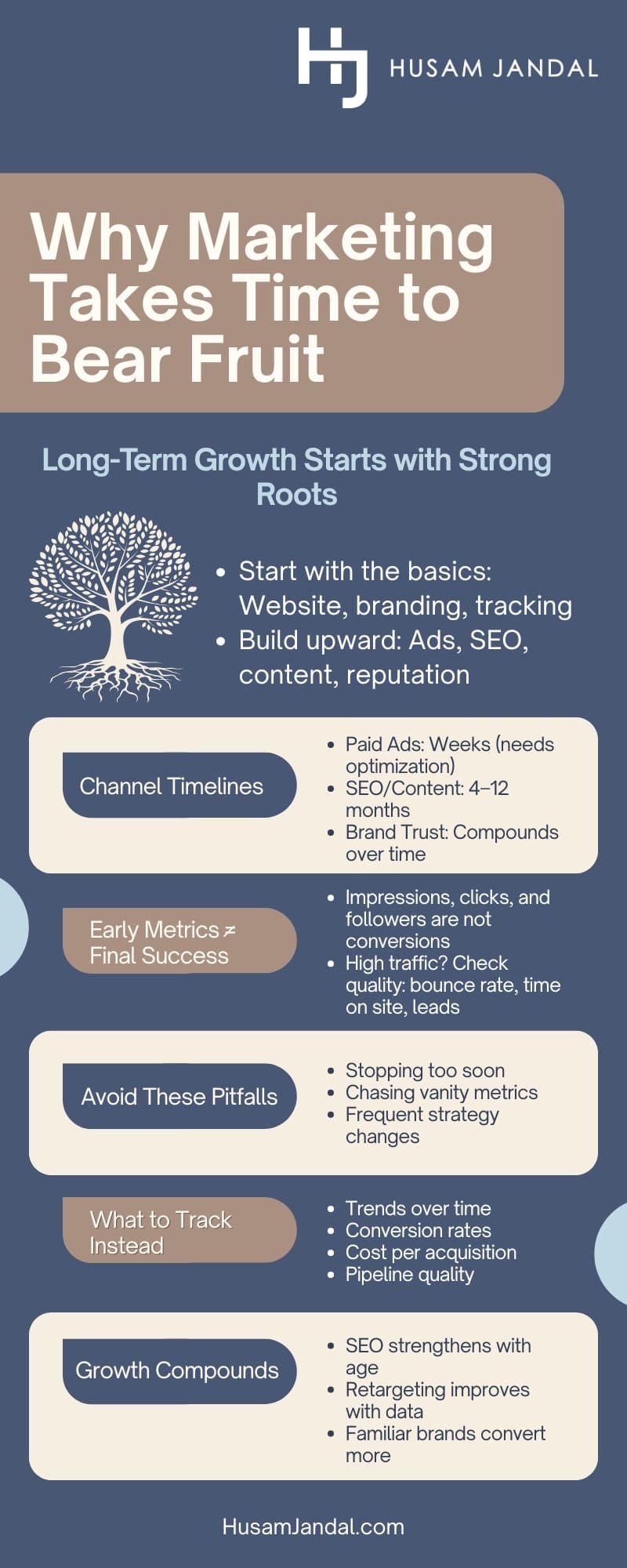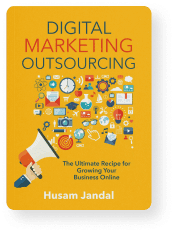 In today’s fast-paced world, you can launch a website in days and begin running paid ads in the blink of an eye. You’ve probably even heard marketing guarantees that promise instant results. Many business leaders become disappointed when they see slow marketing results because of these things. But in digital marketing, patience is a virtue. Give me a few minutes, and I’ll explain why marketing takes time and how longer timelines actually benefit your business.
In today’s fast-paced world, you can launch a website in days and begin running paid ads in the blink of an eye. You’ve probably even heard marketing guarantees that promise instant results. Many business leaders become disappointed when they see slow marketing results because of these things. But in digital marketing, patience is a virtue. Give me a few minutes, and I’ll explain why marketing takes time and how longer timelines actually benefit your business.
Marketing Results Don’t Happen Instantly
I often use the “digital marketing tree” analogy to describe how to deploy initiatives in a way that maximizes results while giving the business clarity and focus. The concept is simple. You start by collecting ground fruit, such as building a website, and work your way up the tree to areas with increasing complexity and resource needs. But digital marketing results, like trees, don’t sprout from nothing. A seed must be planted and tended to first. Moreover, even if you give a sapling perfect conditions, you must still wait for it to mature and bear fruit.
Marketing Strategy Timelines Are Staggered
Every digital channel and strategy follows a different timeline and reaches maturity at its own pace. However, none of them deliver their full potential without the groundwork in place.
- Foundational Strategy Takes Time to Materialize: Initial efforts often focus on building infrastructure: branding, messaging, content, and tracking. These steps don’t produce short-term spikes, but they’re necessary for long-term performance.
- Paid Media Still Needs Optimization: Paid search or social advertising can generate immediate traffic, but effectiveness depends on testing, segmentation, and refinement. Businesses that measure too early may misjudge campaign potential.
- Brand Recognition Compounds: The more often your audience encounters your brand in meaningful contexts, the more likely they are to remember it and respond. But that recognition builds through repetition, not through a single impression or campaign.
- Organic Growth Requires Consistency: Content marketing and search engine optimization (SEO), for example, are designed to build visibility and authority over time. Even with the right strategy, results typically take four to 12 months to produce meaningful results, as Semrush reports.
Consumer Trust and Brand Recognition Play a Role in Results
Modern consumers are skeptical by default. They expect transparency, and they have the tools to fact-check every claim you make. Because of this, trust must be earned over time through consistent action.
- Search Engines Favor the User: Google and other search engines are trying to match the individual person with the best possible results for their needs at that moment. Their algorithms look for signals that a site is trustworthy and reputable. In this regard, branding becomes more important than SEO. It’s often impossible to rank well in saturated industries until you carve out a name for yourself.
- Trust Drives Conversion: Without it, even the most persuasive copy or creative will fall flat.
- Recognition Lowers Customer Acquisition Costs: When your brand is familiar, people respond faster and convert at higher rates. That impacts your entire funnel, from ad performance to close rates.
- Reputation Outlasts Tactics: Businesses that invest in long-term trust and visibility are less dependent on promotional cycles or discounting to move leads through the pipeline.
Set Realistic Marketing Expectations and Expect Gradual Marketing Success
One of the things I appreciate most about the Digital Marketing Tree approach is that quick wins are folded into the strategy early. They give stakeholders confidence they’re moving in the right direction and produce revenue that can be rolled into upcoming initiatives to amplify results and make it easier to invest in digital marketing.
And, while we do expect at least a small uptick in meaningful results like lead generation and new customers, what we’re seeing in this phase is not the end game.
Short-Term Metrics Can Be Misleading
A lot of foundational work is performed before any initiatives are launched when you work with a digital marketing expert. They spend time getting to know your business, your offerings, and what makes your customers tick. This helps start campaigns off on the right foot, but it doesn’t tell us if they respond to some channels, formats, offers, and copy better than others.
Because of this, early-stage reporting is often built around visibility using metrics like clicks, impressions, and followers. These metrics are easy to collect and quick to rise. They can show us we’re on the right track, but they need to be taken in context.
- Vanity Metrics: Metrics like impressions, likes, or follower counts, sometimes called vanity metrics, can indicate progress, but they don’t reflect qualified interest or intent. Campaigns built to generate reach may do so efficiently without driving meaningful engagement or conversions.
- High Traffic, Low Value: A spike in visitors to your website can feel like a win. However, we must still watch metrics like bounce rates, time spent on the website, and conversions to gauge whether it’s the right traffic. If those supporting metrics don’t demonstrate we’re reaching the right audience, we must evaluate why the alignment is off and refine it.
- Lead Volume without Context: Receiving a deluge of leads is exciting, especially if your sales team has been underutilized. However, if they’re now spending their time filtering out unqualified or junk leads and still not getting deals they can close, there’s a problem earlier in the funnel. It takes time to evaluate the fit of these new leads and course correct if necessary.
Track Progress without Getting Discouraged
One of the reasons it’s important to understand why marketing takes time is that, without this knowledge, you will almost certainly hit a point where the numbers seem disconnected from what you’re trying to accomplish. For instance, you’ve seen how strong website traffic or a surge in leads may not actually mean everything is working as it should.
Stakeholders who are unprepared for trial and error in that regard, and those expecting instantaneous results, can get very discouraged at this stage. If initial marketing metrics aren’t reliable indicators of long-term digital marketing success, and you’re too early in your digital marketing strategy timeline to be able to leverage long-term growth metrics, it’s easy to feel that the wrong strategies are being applied or even that digital marketing doesn’t work for your brand. This is where a lot of businesses start to pull back by cancelling initiatives or cutting budgets.
Before you take drastic measures, reconsider how you’re measuring progress and success.
- Monitor Trends, Not Moments: Look at month-over-month trends, not daily spikes. This helps you identify actual movement and avoid overreacting to short-term fluctuations.
- Evaluate Efficiency, Not Just Volume: Focus on conversion rates, cost per acquisition, and pipeline quality. These metrics offer a more complete view of marketing’s contribution to business outcomes.
- Establish a Review Cadence: Monthly or quarterly reviews are more useful than weekly check-ins for evaluating long-term performance. This also gives campaigns time to generate meaningful data before decisions are made.
Maintain Patience and Stay Committed Even When You Get Slow Marketing Results
Even when you understand that long-term brand growth takes time, waiting for results can still be hard. This is another area where the Digital Marketing Tree shines. The framework gives you a clear path forward, so you’re always building toward the next phase. Knowing that you have a strategy like this makes it easier for you to see how things will come together and stay the course. But there are a few tricks you can use along the way to help reinforce this.
Align Marketing Goals with Growth Stages or Phases

If you’re following the Digital Marketing Tree framework, create new goals as you reach upward to each new phase. For instance, goals surrounding the creation or enhancement of your website, when you’re at the ground fruit stage, should focus more on things like online branding and scalability. You can also watch metrics to see if the first people arriving are staying and browsing, indicating that the site is meeting their needs.
As you move up the tree to low-hanging fruit and work on SEO, it’s important to remember that it will likely take several months or longer before you see a serious uptick in traffic unless you already have a strong brand. At the start, you can be measuring the success of individual pages as they’re optimized and seeing how they stack up to similar pages from your competitors.
Consistent Efforts Have a Compounding Effect and Lead to Long-Term Brand Growth
You can raise the bar a little at a time as you continue deploying new tactics and your strategies have time to mature.
- Search Visibility Improves with Time: Organic rankings strengthen as search engines detect consistent value and credibility. Content developed six months ago may outperform everything published last week.
- Retargeting Becomes More Precise: Campaigns reach more qualified audiences when built on a foundation of strong data. That foundation requires time to collect, analyze, and refine.
- Brand Recognition Reduces Resistance: As your brand becomes more familiar in your space, conversion rates increase, even if your ad creative, budget, or offer stay the same.
Avoid Common Pitfalls Associated with Quick Marketing Wins
When businesses expect marketing to produce immediate results, they often take actions that undermine the very outcomes they’re hoping to achieve. Marketing works best when it’s consistent, strategic, and given time to evolve.
Cutting Campaigns Too Soon Can Backfire
Most strategies require time in market to gather feedback, identify patterns, and optimize performance. Ending a campaign early often interrupts that process.
- Limited Data Means Poor Decisions: Short campaigns rarely provide enough data to make informed adjustments. Ending them too early eliminates the opportunity to refine and improve.
- Performance Often Improves After Optimization: Most campaigns underperform at launch. It’s not a failure; it’s a starting point. With each iteration, targeting, messaging, and creative improve. Pulling back before that process unfolds leaves ROI on the table.
- Cutting Too Soon Disrupts Learning Cycles: Paid campaigns, SEO strategies, and email nurture sequences all benefit from historical data. If you start over every time something underdelivers early on, you lose the opportunity to build on what’s been learned.
- Trust Takes Time: Especially in high-consideration markets, multiple touchpoints are needed before a prospect engages. Campaigns that are turned off too quickly fail to meet prospects where they are in the decision cycle.
Chasing Instant Gratification in Marketing Has Risks
Certain quick-win strategies are effective and allow you to start building momentum. However, others that deliver fast results do so at the expense of long-term effectiveness. As you evaluate which quick wins to pursue, be mindful of tradeoffs.
- Overemphasis on Short-Term Tactics Can Damage Reputation: Aggressive ads, overpromising copy, or misleading offers may increase clicks or form fills temporarily, but they erode trust, reduce retention, and generate negative feedback.
- Volume Without Value Undermines Sales Teams: Driving a flood of low-quality leads may look good in a report, but it slows down your sales cycle and wastes internal resources. In some cases, it damages morale if teams start questioning the value of marketing efforts altogether.
- High-Frequency Swaps Signal Instability: Constantly changing direction makes it harder to evaluate what’s working. It also sends mixed signals to your audience, which weakens brand credibility.
Leverage Proven Long-Term Marketing Tactics That Deliver Results
Some marketing strategies build momentum the longer they’re in use. These are the tactics that generate brand equity, improve efficiency over time, and reduce the need to restart efforts every quarter. While they may not deliver immediate spikes, they provide sustained, scalable impact when managed correctly.
The Power of Content Marketing and SEO Increases Over Time

Content and SEO are often misunderstood because they don’t yield quick wins. But when approached with strategy and consistency, they become two of the most cost-effective tools in a company’s marketing mix.
- Content Marketing Builds Authority: Educational content helps your brand earn trust and positions your business as a credible solution provider. As content assets accumulate, they work together to increase reach, improve conversions, and support other marketing initiatives.
- SEO Performance Compounds with Time: Unlike paid campaigns, SEO doesn’t stop working immediately when your budget pauses. While you will need to keep pages updated and aligned with searcher intent, especially in competitive industries, it’s possible for well-optimized pages to generate consistent traffic for years.
- Visibility Improves with Consistency: Google rewards consistent publishing, technical optimization, and user engagement. These factors can’t be rushed, but they do yield measurable growth when nurtured.
- Strategic Content Supports Every Stage of the Funnel: From awareness-building blog posts to in-depth product guides and case studies, content provides the context and clarity that prospects need as they evaluate solutions.
Relationship-Building Enhances Marketing ROI

Businesses that thrive long-term invest in relationships, not just transactions. Marketing that emphasizes connection over clicks typically sees higher customer lifetime value, stronger referral rates, and lower churn.
- Confidence Accelerates the Funnel: When prospects recognize your brand and trust your expertise, they engage more decisively, which reduces sales cycle time and increases close rates.
- Reputation Reduces Acquisition Costs: A known, respected brand spends less to acquire each customer. As word-of-mouth grows and search volume for branded terms increases, efficiency improves across all channels.
- Customer Retention Improves Profitability: Repeat customers cost less to serve and spend more over time. Retention-driven marketing, like email campaigns, loyalty programs, and customer education, helps protect revenue and stabilize forecasting.
- Credibility Creates Competitive Advantage: In saturated markets, product and pricing parity is common. Relationship-building is what helps brands differentiate. It turns satisfied clients into advocates and neutral observers into subscribers or followers.
Get Help Planting the Seeds of Success
My work as a digital marketing consultant is unique because I don’t just strategize and execute. I develop digital marketing systems, touch on areas of sales and operations that feed into them, and deploy strategically. It’s like planting a tree and nurturing it to maturity, so that, when the time comes for your team to take over caring for it, it’s strong and requires only ongoing maintenance and updates to ensure you’re taking advantage of new tools, technology, and trends. When you work with most consultants, or even agencies for that matter, the results often last only for the duration of that relationship because they’re exclusively targeting the quick wins or aren’t building the framework for you to continue using.
That’s not to say I work with businesses for a short period of time. In fact, most engagements last years, and the businesses prefer to continue working with me even after their strategies reach maturity because they’ve seen how it works and have experienced the results. If you’d like to discuss what that might look like for your business, let’s talk.
FAQs on Why Marketing Takes Time
How long does it take to see results from SEO or content marketing?
SEO and content marketing typically take four to twelve months to produce meaningful results. Timelines vary based on competition, website authority, and consistency. Early indicators may appear sooner, but lasting growth takes time.
What is a realistic timeline for digital marketing success?
A realistic timeline depends on your strategy. Paid ads may show results in weeks, while organic tactics like SEO take months. Most businesses start seeing reliable performance trends after three to six months.
How can I tell if my marketing strategy is working early on?
In the early stages, look for signs like increased engagement, higher-quality traffic, and improved user behavior. While conversions may take time, progress in these areas shows your strategy is moving in the right direction.
What should I do if my marketing isn’t generating leads right away?
Start by reviewing the quality of your traffic, messaging, and targeting. Early lead gaps don’t always signal failure. They often point to areas that need refinement. Allow time for optimization before making major changes.
Are there any fast marketing strategies that actually work?
Paid ads and retargeting can produce quick results, especially with strong offers and clear targeting. However, ongoing optimization is required to ensure they produce the best possible results. Moreover, sustainable growth still requires longer-term strategies like content, SEO, and brand development.
Why am I getting traffic but no conversions from my marketing?
High traffic with low conversions usually means a mismatch between the audience and your offer, or friction in your user experience. Evaluate relevance, landing pages, and trust signals like reviews or guarantees.
When should I start seeing ROI from a digital marketing campaign?
Paid campaigns may show ROI in one to three months. Organic efforts like SEO and content often take longer. Overall ROI should be evaluated quarterly or longer to account for refinement and learning.
How do I know if I should keep going or pivot my marketing plan?
If you're seeing gradual improvements in traffic quality, engagement, or conversions, stay the course. Pivot only if data shows consistent underperformance despite optimization and strategic alignment.
What are the most important metrics to track early in a marketing campaign?
Early on, track engagement metrics like bounce rate, time on site, and click-through rate. These help you gauge initial audience interest and alignment before deeper performance metrics take hold.





































































